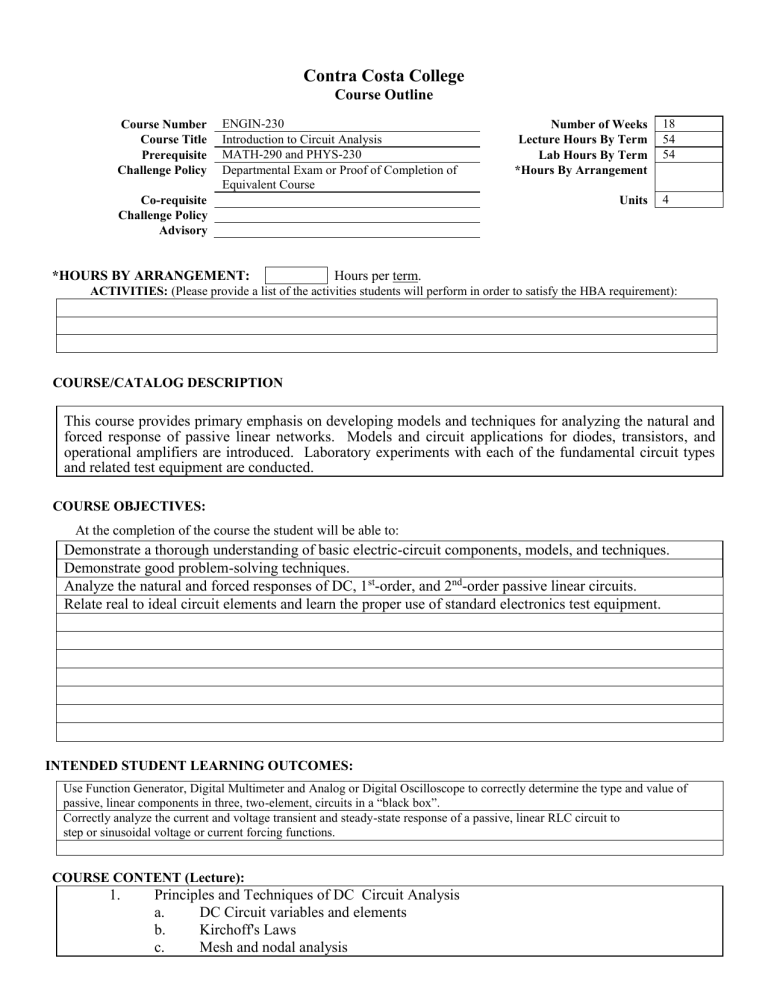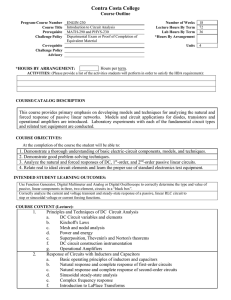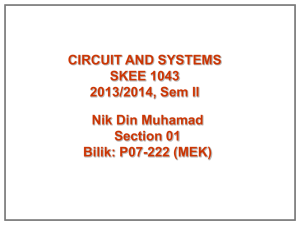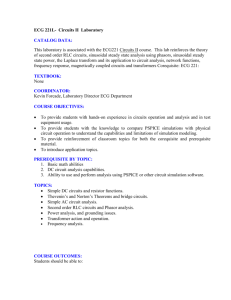ENGIN 230-S15.doc 99KB Feb 05 2015 09:12:18 AM

Contra Costa College
Course Outline
Course Number ENGIN-230
Course Title Introduction to Circuit Analysis
Prerequisite MATH-290 and PHYS-230
Number of Weeks 18
Lecture Hours By Term 54
Lab Hours By Term 54
*Hours By Arrangement
Equivalent Course
Co-requisite
Challenge Policy
Advisory
Units 4
*HOURS BY ARRANGEMENT: Hours per term.
ACTIVITIES: (Please provide a list of the activities students will perform in order to satisfy the HBA requirement):
COURSE/CATALOG DESCRIPTION
This course provides primary emphasis on developing models and techniques for analyzing the natural and forced response of passive linear networks. Models and circuit applications for diodes, transistors, and operational amplifiers are introduced. Laboratory experiments with each of the fundamental circuit types and related test equipment are conducted.
COURSE OBJECTIVES:
At the completion of the course the student will be able to:
Demonstrate a thorough understanding of basic electric-circuit components, models, and techniques.
Demonstrate good problem-solving techniques.
Analyze the natural and forced responses of DC, 1 st -order, and 2 nd -order passive linear circuits.
Relate real to ideal circuit elements and learn the proper use of standard electronics test equipment.
INTENDED STUDENT LEARNING OUTCOMES:
Use Function Generator, Digital Multimeter and Analog or Digital Oscilloscope to correctly determine the type and value of passive, linear components in three, two-element, circuits in a “black box”.
Correctly analyze the current and voltage transient and steady-state response of a passive, linear RLC circuit to step or sinusoidal voltage or current forcing functions.
COURSE CONTENT (Lecture):
1. Principles and Techniques of DC Circuit Analysis a. DC Circuit variables and elements b. Kirchoff's Laws c. Mesh and nodal analysis
d. Power and energy e. Superposition, Thevenin's and Norton's theorems f. DC circuit construction instrumentation g. Operational Amplifiers
2. Response of Circuits with Inductors and Capacitors a. Basic operating principles of inductors and capacitors b. Natural response and complete response of first-order circuits c. Natural response and complete response of second-order circuits d. Sinusoidal steady-state analysis e. Complex frequency response f. Introduction to LaPlace Transforms
3. Semiconductor Principles a. The semiconductor diode b. Operation of bipolar and field-effect transistors c. Introduction to digital logic
4. Circuit Analysis with Computer-simulations a. Introduction to PSPICE b. Application of PSPICE to DC circuits c. Application of PSPICE to find the transient and steady-state response of RLC circuits
COURSE CONTENT (Lab):
PSpice and passive sign convention
I-V Curves (sources and sinks)
Voltmeters
Operational amplifiers
Thevenin’s and Norton’s equivalent circuits
Transient and DC-steady state response in 1 st
order circuits
Natural and steady-state response in RLC parallel circuits
Natural and steady-state response in RLC series circuits
Analysis of steady-state sinusoidal voltages (phasors)
RLC identification (“black box”)
Power factor correction and maximum power theorem
Analog to digital converter (ADC)
METHODS OF INSTRUCTION:
Classroom presentation is largely lecture/demonstration with many opportunities allowed for questions of and by the students. Many of the basic concepts and their applications are illustrated with laboratory experiments, computer simulations and exercises.
INSTRUCTIONAL MATERIALS:
NOTE: To be UC/CSU transferable, the text must be dated within the last 7 years OR a statement of justification for a text beyond the last 7 years must be included.
Textbook Title: Electric Circuits
Author: Nilsson and Riedel
Publisher: Pearson Prentice Hall
Edition/Date: 9 th Edition/ Copyright 2010
Justification Statement: (For textbook beyond 7 years)
Textbook Reading Level:
Lab Manual Title Contra Costa College Engineering 230 Lab Manual
Author: Wieber, D., et al.
Publisher: Contra Costa College Bookstore
Edition/Date: Spring 2015
OUTSIDE OF CLASS WEEKLY ASSIGNMENTS:
Title 5, section 55002.5 establishes that a range of 48 -54hours of lecture, study, or lab work is required for one unit of credit.
For each hour of lecture, students should be required to spend an additional two hours of study outside of class to earn one unit of credit.
Title 5, section 55002(a) 2F establishes that coursework calls for critical thinking and the understanding and application of concepts determined by the curriculum committee to be at college level.
For degree applicable courses: List one example of critical thinking homework
Outside of Class Weekly Assignments Hours per week
Weekly Reading Assignments (Include detailed assignment below, if applicable) 3
Read Chapter 7, pages 277 - 321
Weekly Writing Assignments (Include detailed assignment below, if applicable)
Weekly Math Problems (Include detailed assignment below, if applicable) 3
Chapter 7: Problems 1, 3, 8, 10, 23, 26, 28, 33, 39,43
Critical thinking homework example:
How much power is dissipated in a 10 ohm resistor connected to a 10 volt source?
Lab or Software Application Assignments (Include detailed assignment below, if applicable)
Other Performance Assignments (Include detailed assignment below, if applicable)
STUDENT EVALUATION : (Show percentage breakdown for evaluation instruments)
Title 5, section 55002 (a) 2A establishes that the grade is based on demonstrated proficiency in subject matter and the ability to demonstrate that proficiency.
For degree applicable courses: Course requires essay writing, or, in courses where the curriculum committee deems them to be appropriate, by problem solving exercises, or skills demonstrations by students.
% Essay
% Computation or Non-computational Problem Solving Skills
% Skills Demonstration
70 % Objective Examinations
Other (describe)
15 % Lab assignments
15 % Homework
%
GRADING POLICY: (Choose LG, P/NP, or SC)
X Letter Grade
90% - 100% = A
80% - 89% = B
70% - 79% = C
60% - 69% = D
Below 60% = F
Percentages vary from instructor to instructor
Pass / No Pass
70% and above = Pass
Below 70% = No Pass
Student Choice
90% - 100% = A
80% - 89% = B
70% - 79% = C
60% - 69% = D
Below 60% = F or
70% and above = Pass
Below 70% = No Pass
Prepared by: Jon Celesia and Mark Wong
Date: Spring 2015
Revised form 09/14






